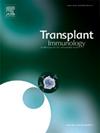双不相关脐带血移植成功治疗1例供体特异性抗原阳性成人患者的极严重再生障碍性贫血:1例报告和复习。
IF 1.4
4区 医学
Q4 IMMUNOLOGY
引用次数: 0
摘要
为了克服脐带血的细胞剂量屏障,双无关脐带血移植(UCBT)在成人严重再生障碍性贫血(SAA)中越来越普遍。预先存在的供体特异性hla抗体(dsa)是移植物失败的一个危险因素。应进行脱敏治疗以降低循环DSA水平,从而降低GF的风险。本文报告一例女性患者获得性SAA和移植前抗hla抗体。移植前使用利妥昔单抗、静脉注射免疫球蛋白(IVIG)和血浆置换(PE)进行脱敏治疗,并使用氟达拉滨(30 mg/m2,连续6天)和环磷酰胺(50 mg/kg/d,连续4天)作为调节方案。DSA滴度显著降低;患者成功接受双不相关UCBT治疗。目前,完全缓解(CR)状态在UCBT后维持了一年多,没有移植物抗宿主病的迹象。我们的研究结果支持在单单位UCB细胞剂量不足的成年SAA患者中使用双单位无关UCBT。在UCBT前后监测和降低DSA水平是降低GF风险的有效方法。本文章由计算机程序翻译,如有差异,请以英文原文为准。
Successful treatment of very severe aplastic anemia with double unrelated umbilical cord blood transplantation in a donor-specific antigen positive adult patient: A case report and review
To overcome the cell-dose barrier of cord blood, double unrelated umbilical cord blood transplantation (UCBT) has become increasingly common in adults with severe aplastic anemia (SAA). Pre-existing donor-specific anti-HLA antibodies (DSAs) represent a risk factor for graft failure (GF). Desensitization therapy should be conducted to reduce circulating DSA levels, thereby decreasing the risk of GF. This report details a case of a female patient with acquired SAA and pre-transplantation anti-HLA antibodies. Desensitization with rituximab, intravenous immunoglobulin (IVIG), and plasma exchange (PE) was performed before transplantation with a conditioning regimen of fludarabine (30 mg/m2 for six days) and cyclophosphamide (50 mg/kg/d for four days). DSA titers were significantly reduced; the patient was successfully treated with double unrelated UCBT. Currently, complete remission (CR) status has been maintained for over a year after UCBT, with no signs of graft-vs-host disease. Our findings support the use of double-unit unrelated UCBT in adult patients with SAA when cell doses of single-unit UCB are inadequate. Monitoring and reducing DSA levels before and after UCBT is an efficient way to reduce the risk of GF.
求助全文
通过发布文献求助,成功后即可免费获取论文全文。
去求助
来源期刊

Transplant immunology
医学-免疫学
CiteScore
2.10
自引率
13.30%
发文量
198
审稿时长
48 days
期刊介绍:
Transplant Immunology will publish up-to-date information on all aspects of the broad field it encompasses. The journal will be directed at (basic) scientists, tissue typers, transplant physicians and surgeons, and research and data on all immunological aspects of organ-, tissue- and (haematopoietic) stem cell transplantation are of potential interest to the readers of Transplant Immunology. Original papers, Review articles and Hypotheses will be considered for publication and submitted manuscripts will be rapidly peer-reviewed and published. They will be judged on the basis of scientific merit, originality, timeliness and quality.
 求助内容:
求助内容: 应助结果提醒方式:
应助结果提醒方式:


